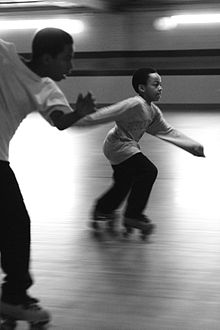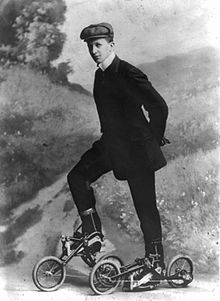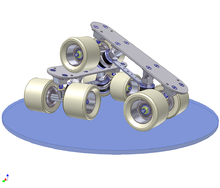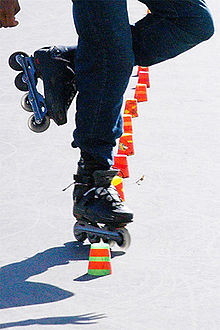
Roller skating
Did you know...
SOS Children have produced a selection of wikipedia articles for schools since 2005. SOS Children works in 45 African countries; can you help a child in Africa?
Roller skating is the traveling on surfaces with roller skates. It is a form of recreational activity as well as a sport, and can also be a form of transportation. Skates generally come in three basic varieties: quad roller skates, inline skates or blades and tri-skates, though some have experimented with a single-wheeled "quintessence skate" or other variations on the basic skate design. In America, this hobby was most popular in the 1970s and the 1990s.
History
- 1743: First recorded use of roller skates, in a London stage performance. The inventor of this skate is lost to history.
- 1760: First recorded skate invention, by John Joseph Merlin, who demonstrated a primitive inline skate with metal wheels.
- 1819: First patented roller skate design, in France by M. Petitbled. These early skates were similar to today's inline skates, but they were not very maneuverable; it was very difficult with these skates to do anything but move in a straight line and perhaps make wide sweeping turns.
- Rest of the 19th century: inventors continued to work on improving skate design.
- 1863: The four-wheeled turning roller skate, or quad skate, with four wheels set in two side-by-side pairs, was first designed, in New York City by James Leonard Plimpton in an attempt to improve upon previous designs, The skate contained a pivoting action using a rubber cushion that allowed the skater to skate a curve just by leaning to one side. It was a huge success, so much that the first public skating rink was opened in 1866 in Newport, Rhode Island with the support of Plimpton. The design of the quad skate allowed easier turns and maneuverability, and the quad skate came to dominate the industry for more than a century.
- 1876: William Brown in Birmingham, England patented a design for the wheels of roller skates. Brown's design embodied his effort to keep the two bearing surfaces of an axle, fixed and moving, apart. Brown worked closely with Joseph Henry Hughes, who drew up the patent for a ball or roller bearing race for bicycle and carriage wheels in 1877. Hughes' patent included all the elements of an adjustable system. These two men are thus responsible for modern day roller skate and skateboard wheels, as well as the ball bearing race inclusion in velocipedes -- later to become motorbikes and automobiles. This was arguably, the most important advance in the realistic use of roller skates as a pleasurable pastime.
- 1876: The toe stop was first patented. This provided skaters with the ability to stop promptly upon tipping the skate onto the toe. Toe stops are still used today on most quad skates and on some types of inline skates.
- 1877: The Royal Skating indoor skating ring building is erected rue Veydt, Brussels.
- 1880s: Roller skates were being mass produced in America from then. This was the sport's first of several boom periods. Micajah C. Henley of Richmond, Indiana produced thousands of skates every week during peak sales. Henley skates were the first skate with adjustable tension via a screw, the ancestor of the kingbolt mechanism on modern quad skates.
- 1884: Levant M. Richardson received a patent for the use of steel ball bearings in skate wheels to reduce friction, allowing skaters to increase speed with minimum effort.
- 1898: Richardson started the Richardson Ball Bearing and Skate Company, which provided skates to most professional skate racers of the time, including Harley Davidson (no relation to the Harley-Davidson motorcycle brand). (Turner and Zaidman, 1997).
-
- The design of the quad skate has remained essentially unchanged since then, and remained as the dominant roller skate design until nearly the end of the 20th century. The quad skate has begun to make a comeback recently due to the popularity of roller derby and jam skating.
- 1979: Scott Olson and Brennan Olson of Minneapolis, Minnesota came across a pair of inline skates created in the 1960s by the Chicago Roller Skate Company and, seeing the potential for off-ice hockey training, set about redesigning the skates using modern materials and attaching ice hockey boots. A few years later Scott Olson began heavily promoting the skates and launched the company Rollerblade, Inc..
During the late 1980s and early 1990s, the Rollerblade-branded skates became so successful that they inspired many other companies to create similar inline skates, and the inline design became more popular than the traditional quads. The Rollerblade skates became synonymous in the minds of many with "inline skates" and skating, so much so that many people came to call any form of skating "Rollerblading," thus becoming a genericized trademark.
For much of the 1980s and into the 1990s, inline skate models typically sold for general public use employed a hard plastic boot, similar to ski boots. In or about 1995, "soft boot" designs were introduced to the market, primarily by the sporting goods firm K2 Inc., and promoted for use as fitness skates. Other companies quickly followed, and by the early 2000s the development of hard shell skates and skeletons became primarily limited to the Aggressive inline skating discipline and other specialized designs.
The single-wheel "quintessence skate" was made in 1988 by Miyshael F. Gailson of Caples Lake Resort, California, for the purpose of cross-country ski skating and telemark skiing training. Other skate designs have been experimented with over the years, including two wheeled (heel and toe) inline skate frames but the vast majority of skates on the market today are either quad or standard inline design.
Artistic roller skating
Artistic roller skating is a sport which consists of a number of events. These are usually accomplished on quad skates, but inline skates may be used for some events. Various flights of events are organized by age and ability/experience. In the US, local competitions lead to 9 regional competitions which lead to the National Championships and World Championships.
Figures
Skaters skate around a series of circles or ovals to show control and accuracy.
Dance
In competition skaters can enter more than one event;
Solo Dance; solo dance starts at novice and goes up to gold star. You take tests to skate in harder categories. In competition these dances are set patterns and the judges give you marks for good edges, how neat they look and how well they do turns, etc.
Duo Dance; this is where two people skate together doing the set dances. Most people skate with a partner the same ability.
Teams; 3 people skating separately solo dances all points get added up together
Trio dance; 3 people skate together and they get marked on how well their feet match.
Skaters are judged by the accuracy of steps that they skate when performing a particular dance. In addition to being judged on their edges and turns, skaters must carry themselves in an elegant manner while paying careful attention to the rhythm and timing of the music.
Freestyle
An individual event where creativity is emphasized. Includes jumps, spins and choreographed movements to music.
Precision teams
A team of skaters (usually counted in multiples of 4) creates various patterns and movements to music. Often used elements include skating in a line, skating in a box, 'splicing' (subgroups skating towards each other such that they do not contact each other), and skating in a circle. The team is judged on its choreography and the ability to skate together precisely..
Singles and pairs
A single skater or a pair of skaters present routines to music. They are judged on skating ability and creativity. Jumps are expected in these events.
Speed skating
Inline speed skating is a competitive non-contact sport played on inline skates. Variants include indoor, track and road racing, with many different grades of skaters, so the whole family can compete.
Group skating
Among skaters not committed to a particular discipline, a popular social activity is the group skate or street skate, in which large groups of skaters regularly meet to skate together, usually on city streets. Although such touring existed among quad roller skate clubs in the 1970s and 1980s, it made the jump to inline skates in 1990 with groups in large cities throughout the United States. In some cases, hundreds of skaters would regularly participate, resembling a rolling party. In the late 1990s, the group skate phenomenon spread to Europe and east Asia. The weekly Friday night skate in Paris, France (called Pari Roller) is believed to be one of the largest repeating group skates in the world. At times, it has had as many as 35,000 skaters participating on a single night. The Sunday Skate Night in Berlin also attracts over 10,000 skaters during the summer, and Copenhagen, Munich, Frankfurt, Amsterdam, Buenos Aires, London, San Francisco, Los Angeles, New York, and Tokyo host other popular events. Charity skates in Paris have attracted 50,000 participants (the yearly Paris-Versailles skate).
Aggressive inline
Aggressive inline skating is trick-based skating. This is where the individual performs tricks using a slightly different skate to normal. The skate has a grind block in between two wheels and the various companies have designed the boots to take these extra strains. Also the wheels have a flat large contact surface for grip.
Aggressive inline can either take place at a skate park or on the street. Typically predominantly grinds but also air tricks such as spins and flips.
Roller hockey (quad)
Roller hockey is the overarching name for a rollersport that existed long before inline skates were invented. Roller hockey has been played on quad skates in many countries worldwide and so has many names. Roller hockey at the 1992 Summer Olympics was a demonstration rollersport in the 1992 Summer Olympics in Barcelona.
Skating federations
In the United States, the controlling organization is USA Roller Sports, headquartered in Lincoln, Nebraska, also home of the National Museum of Roller Skating. Nationals are held each summer with skaters required to qualify through regional competitions.
Roller derby
Roller derby is a team sport played on roller skates on an oval track. Originally a trademarked product developed out of speed skating demonstrations, the sport is currently experiencing a revival as a grass-roots-driven 5-a-side sport played mainly by women. Most roller derby leagues adopt the rules and guidelines set by the Women's Flat Track Derby Association or its male counterpart, Men's Roller Derby Association, but there are leagues that play on a banked track, as the sport was originally from c.1933-1998.
Other groups
Other groups include:
- International Roller Sports Federation (Fédération Internationale de Roller Sports)
- British Federation of Roller Skating
- Skate Australia
In popular culture
- 1955 - Gene Kelly used roller skates as part of a dance routine in It's Always Fair Weather.
- 1971 - The song Brand New Key by Melanie Safka uses roller skates as a theme.
- 1979 - Roller Boogie with Linda Blair
- 1980 - Xanadu, with Olivia Newton-John, has rollerskating as a recurring theme.
- 1980 - Heaven's Gate with Kris Kristofferson and Christopher Walken, which is set in 1890s Wyoming, features a scene in an early roller skating
- 1995 - " Man of the House" features a scene where Jonathan Taylor Thomas uses early model rollerblades to get around Seattle.
- 1998 - In the Disney Channel Original Movie Brink!, in-line skating is presented as an extreme competition for teens in California.
- 2005 - The plot of the film Roll Bounce centered around a group of teenagers who compete in a rollerskating competition in the late 1970s.
- 2006 - In the movie ATL, set in Atlanta, the protagonist – rapper, T.I. – and his friends had a great love for skating.
- 2008 - MTV's Americas Best Dance Crew auditioned Breaksk8, a group of Hip Hop dancers on roller skates.
- 2008 - The songs "Seventies" by Laurent Wolf and "Kim&Jessie" by M83, featured the "Miss'ile" skate dancers
- 2009 - The movie Whip It, starring Ellen Page and Drew Barrymore – Barrymore also directing – centers around a small-town girl who joins a hard core all-girl roller derby team.
- 2010 - In the movie Skateland, starring Shiloh Fernandez and Ashley Greene, which is set in the 1980s, when roller skating was very popular and many teenagers used to go to roller rinks.
Alternatives
Roller skating, like skateboarding, has created a number of spin-off sports and sports devices. In addition to rolelerblades/inline skates, there have also been:
- Soaps, normal-looking street/ skate shoes with a concave plastic plate in the sole to allow grinds
- Heelys, normal-looking street/skate shoes with a single retractable wheel in the heel of each shoe, allowing the wearer to perform unique rollerskating-like moves at leisure while still walking normally when the skating functionality isn't desired (and the wheel is mostly retracted into a recessed slot in the heel). The fact that skateboarding and related wheeled sports are outlawed in many cities and suburbs makes the low key and spontaneous nature of Healys all the more enticing to the same demographic. Heelys were later also combined with Soaps into a single hybrid shoe.
- Freeline skates, a class of un-attached skates that wearers place under their normal street or skate shoes. They typically have 2 closely set inline wheels set with a short base under a small squarish plate (usually surfaced with grip tape about the same width width as the rider's shoe. This arrangement allows for a range of motion similar to single-wheeled skates like Healys. Due to the lack of straps on the contact plate, freeline skates require constant motion to stay on, and are a particular challenge for novices.
- Two-wheeled skates, there are also other lesser seen two-wheeled skate arrangements. Some resemble inline skates but with 2 very large wheels bolted in at an angle from the outside rather than a centre-balanced row of 4 smaller wheels underneath of inline skates. Others resemble freeline skates in that they have a small squarish platform, but with 2 medium-sized wheels on either side, somewhat between a freeline skate and roller skates (but with inline-skate-styled wheels).
- Orbit wheel skates, another spiritual relative of the freeline skate whereby the skate stands on a grip-tape-surfaced platform (just slightly larger than a freeline skate's) inside of a large hoop that contains a trapped wheel that can freely rotate under the grip plate each foot is planted on. The foot plates normally rest on the trough of the inner surface of these orbital wheels, with the toes pointing orthogonal to the rotation of the ringed wheel. It's said the experience of riding them is somewhat similar to skateboarding, and there are variants with the two wheels connected so the rider is fixed in a skateboarding-like stance.







